Crypto Academy Season 3 week 7| Blockchain Oracles - by Professor @allbert | Homework task - by @pangoli
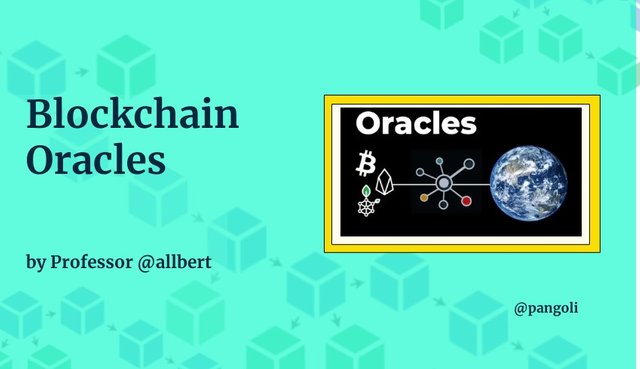
My own work
Hey guys...
I'm really excited to be part of this week's lecture on blockchain oracles led by the amiable Professor @allbert. I really did learn a lot and below is my entry for the homework task.
Introduction
The blockchain is often argued to be a revolutionary technology that will transform how things are done on the internet. For the short historical path, the blockchain has championed a radical change in the way money is created and transacted.
However, all the innovations of the Blockchain technology seem to have originated from within itself, making it a constant subject of debate as to how entities in the real world will benefit from the technology as well.
There seemed to be no established connection between the activities of the real world and the blockchain; and by implication, it seemed the data generated in both worlds ran at parallels. Right there, a gap existed - the need to have a linkage between real-life and the blockchain. This marked the beginning of Blockchain oracles.
In the journey to a wider adoption of Blockchain solutions, several innovations have taken place and Blockchain Oracles are one of those.
Simply put, oracles are off-chain resources used to execute smart contracts on a blockchain. Think of it as a bridge that aids the transmission of off-chain data to the blockchain.
A typical example of a blockchain Oracle is Chainlink, which has already been explained in details by Professor @allbert in this week's lecture post (click here to see post). For my work, I will be looking at another blockchain Oracle called the Band protocol.
Q1: History and Description. Does it have any token or cryptocurrency associated? Explain.
History and description
According to doc.bandchian.org, Band Protocol is a cross-chain data oracle platform that aggregates and connects real-world data and APIs to smart contracts. It is a Blockchain solution that was born out of the technical knowledge of three creators - Soravis Srinawakoon, Paul Chonpimai and Sorawit Suriyakarn.
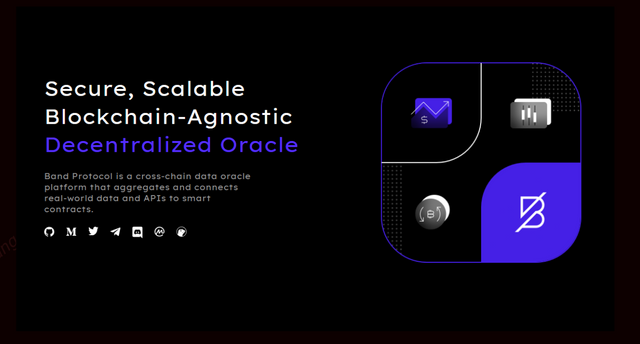
Image source
Band protocol was first built in 2019 on the Ethereum network according to the ERC-20 standards, and later got relaunched as native tokens - BAND -on the Band Protocol mainnet known as BandChain, which is on the Cosmos network . The effectiveness of the Band protocol is traceable to the Cosmos network, which is an inter-operability focused base-layer solution.
One disadvantage of Blockchain solutions like Ethereum was the fact that it does not have the infrastructure to communicate effectively with other blockchains, a simple way of saying that it is not interoperable with other blockchains. Hence, it is difficult or impossible to transfer value in different tokens across different blockchain networks.
For instance, Bitcoin cannot transact on the Ethereum blockchain without first going through a process called wrapping. These interoperability issues frustrate the ability to make cross-chain transactions with cryptocurrencies.
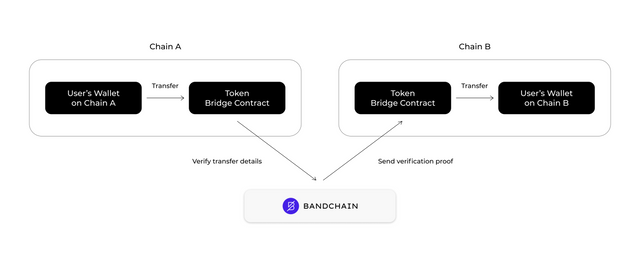
Image source
However, with the Inter-Blockchain Communication Protocol (IBC) of the Cosmos network, the Band protocol is secure, scalable and blockchain-agnostic. That is, it can serve data across different blockchains.
Also, given the Tendermint consensus algorithm on the Cosmos network, this means that the data on Band protocol can be served must faster when compared to other blockchains with either Proof of Work consensus, or other forms of Proof of Stake.
This scalability feature makes the Band protocol stand at an advantage when considering smart contracts compatibility and cost of transactions. It makes up for the secure collection of data from authentic and varified sources, and due to its network speed, becomes more suitable for commuting data types that need to be constantly updated onto the blockchain.
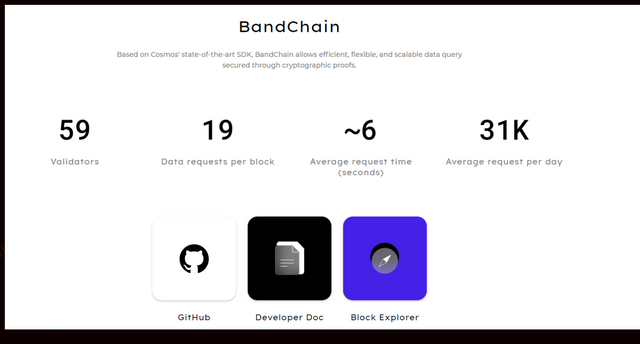
Image source
Band protocol has a robust network comprising of 59 validators who process a total of 19 data requests per block, and oversee the execution of thirty-one thousand average daily request.
Token or associated Cryptocurrency
BAND is the native token of the Band ecosystem. As at the time of writing this article, BAND has the following token information according to coingecko.org
| Band token | Key information |
|---|---|
| Band price | $8.07 |
| Coin rank | #182 |
| Market Capitalization | $290,014,360 |
| Total supply | $100,000,000,000 |
| Circulating supply | $35,191,821 |
| Exchange | Binance, Coinbase, Huobi, Okex, Kraken |
| Website | bandprotocol.com |
| Social media | GitHub |
| " " | |
| " " | Medium |
| " " | Telegram |
The BAND token serves as a reward token and the native currency of the Band protocol, incentivizing block producers to produce new blocks and process data requests on the BAND ecosystem.
The token has price positive economics from the staking mechanism, demand by users for gas fees, demand for participation in governance, and demand by investors to hodl.
BAND token has been listed on reputable exchanges like Binance, Coinbase, Huobi, Okex, Crypto.com, etc. This goes to establish the potential of the BAND token to see explosive price appreciation as economic factors create more demand for the token.
Q2: Functionalities and real-life applications.
The Band protocol
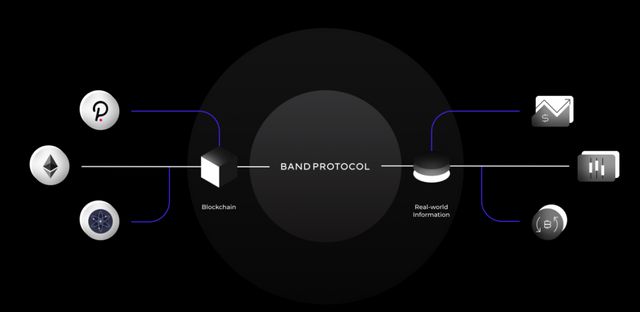
Image source
Following the underlying technology of the Band protocol, some key functions that it serves include the following:
Enabling cross-chain transactions between on-chain sources: based on the interoperability functions built into the Band protocol, it supports interactions between different blockchains.
Providing a bridge to get real-life data on the blockchain: the protocol is able to commute real-world data to blockchain applications known as DApps (Decentralized Applications).
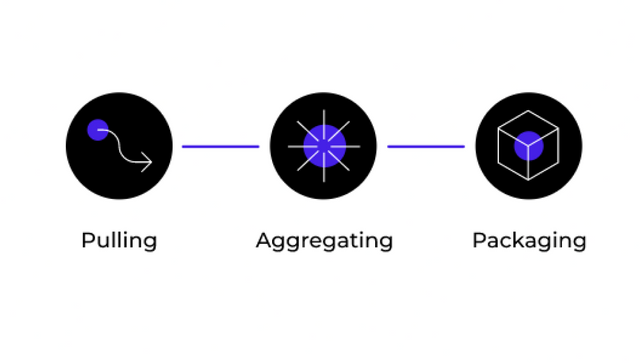
Image source
Through the process of Pulling, Aggregating and Packaging, the Band Oracle supplies reputable and authentic real-world data to blockchains. Thereby, making room for the utilization of Blockchain solutions in areas like Sports, Elections and Voting, Medicine, Finance, Education, Supply chain, etc., as these sectors have a lot to do with real-time data.
Also, the practical functionality of the Band protocol can be seen in the following instances:
Decentralized Standard Price Reference
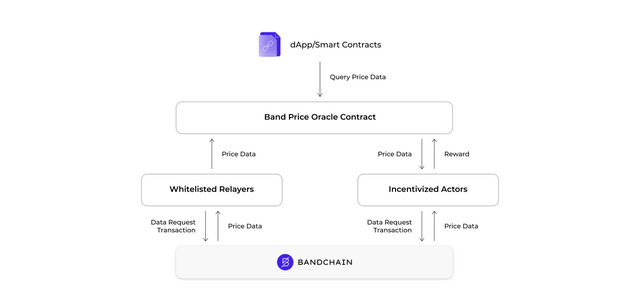
Image source
The Band protocol provides a decentralized data feed that allows anybody too send price update and transactions to the band oracle by themselves.
Financial insurance
A system of decentralized insurance has been in the works in the Blockchain ecosystem. Insurance providers like the Polkacover network will need a reliable source of on-chain data to track trigger events, and effect settlements accordingly. Only blockchain oracles like Band protocol can supply such information in their verified and authentic formats.
Asset Management
Blockchain Projects like Alpha Finance have launched a frontier into the asset management facet of the DeFi ecosystem. With its integration of the Band protocol, Band Oracles play an important role to ensure that the lending market within Alpha Finance' ecosystem utilizes real-time price feeds for a basket different digital assets.
Decentralized Asset Bridges
Blockchain networks and platforms are increasing in number at a very fast pace. In order to enhance the experience of the teaming users, trustless token bridges have become critical in ensuring that capital flow and user experience come off very effienct. With the blockchain-agnostic band Oracles, this can be achieved at scale with a reduced cost.
In practice, when someone wants to request information using the Band protocol, they submit a smart contract to the Band chain, with the details of the information that they want to acquire. The validator that supplies the needed information is rewarded in Band token, and the centralized data providers receive their own reward as well.
BAND TOKEN (use-cases)
The BAND token has practical use cases and these use-cases impact the price of the token. Below are some use-cases of the BAND token:
- Token holders can stake their BANDs to partake in the network as validators and earn rewards proportional to the amount of BANDs they staked.
- Token holders can delegate their idle BANDs to other validator nodes for a fee. These validator nodes will in turn participate in network activities and decision making.
- A BAND token holder can stake his token to directly participate in the governance process of the Band protocol by voting on changes. Also, token holders can delegate their voting powers by relinquishing their tokens to other validators on the network.
- Users of the protocol will always need pay fees in order to process transactions and run computations. On the Band ecosystem, these fees are only payable using the BAND token.
Q3: Pros and Cons

Image source
A general perception of the Band protocol might seem like it is the next best thing that happened to the world after Bitcoin. But, in truth, is it really without a fault? We will explore the pros and cons of this nascent protocol in this segment to see if it is a hundred percent blameless.
Pros
- The protocol is scalable and can process transactions faster than PoW or other forms of PoS based protocols
- It promotes blockchain inter-operability by providing an infrastructure to facilitate cross-chain transactions.
- Its ability to commute off-chain resources to on-chain blockchain applications has opened up ways to further drive blockchain adoption in the real world.
- Centralized web data sources like coinmarketcap, coingecko, sports scores, etc., can be rewarded for provided data to the blockchain oracle.
- It provides a medium for blockchain applications to access secure and verified data from cross-chain and off-chain sources.
Cons
- There are few validators on the network. This can pose a risk as the few validators can easily team up to make critical decisions.
- The security of the network is handled by few validators. Where users are not actively participating in network decisions, the security of the network sits at the mercy of the few validators. This can make a 51% attack easily achievable.
- Since voting power is based on how many BAND tokens a validator holds, there might be unfair acquisition of tokens through lobbying for delegation from large holders.
Q4: Future developments and new projects
The Band protocol is a great innovation for the DeFi ecosystem, and is just in its infancy stage.
Their development roadmap aims at completing the building of BandChain in 3 more phases that will fully set up the blockchain oracle solution for multi-faceted data functions.

Image source
As of October 15th 2020, phase 1 - named Guanyu -of the Bandchain building process had been completed and saw the decentralization if the Band protocol by onboarding 60+ validators. By May 21st 2021, Phase 2 - named Laozi - was already in the testnet. With the success of Phase 2 testnet, an upgrade proposal has been submitted for the mainnet launch.
This BandChain upgrade to Phase 2 - named Laozi, will bring a scalable feature of cross-chain compatibility, improved performance, and streaming revenue to data providers. Once successful, the Band protocol will have successfully completed the creation of a cross-chain oracle that rewards data providers in real time with convertible BAND tokens.
However, there has been other strategic milestones achieved by the Band protocol. They include:
Image source
- The integration with Google cloud to enable immediate and accurate analysis of financial time series data.
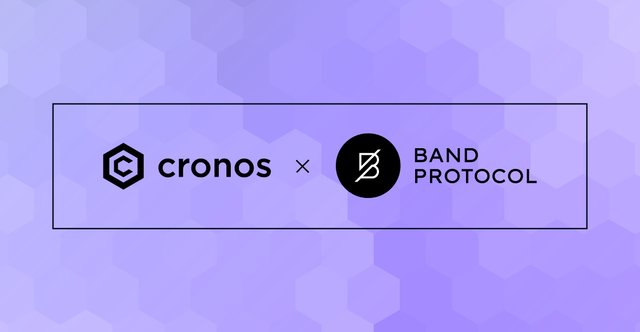
Image source
- The integration with Cronos chain, which is an Ethereum Virtual Machine (EVM) - compatible chain developed by the crypto.com team. This project is making Band protocol the Oracle for its decentralized end-to-end applications.
- Some startegic partnerships with other projects like the Fantom team, Eden network, and Alpha Finance, who are deploying Brand protocol to serve as oracle for several kinds of data, ranging from price data to insurance trigger events
- Also, the Band protocol has been listed on many exchanges like Binance, Coinbase, Huobi, Okex, and has just recently gotten listed on Kraken
The above points are just few of what is in the pack for Band protocol, we can only anticipate what phase 3 will unveil.
Conclusion
The future will consistently see an explosion in the release of new Blockchain projects. The drive to mass adoption of Blockchain solutions across several industries will necessitate more need for smart contracts to communicate and reference data from off-chain and cross-chain sources.
Hence, blockchain oracles like the Band protocol are a great innovation that will make the application of Blockchain solutions to real-world problems a reality.
Thanks for reading...
Hello, @ Thank you for participating in Steemit Crypto Academy season 3 week 7.